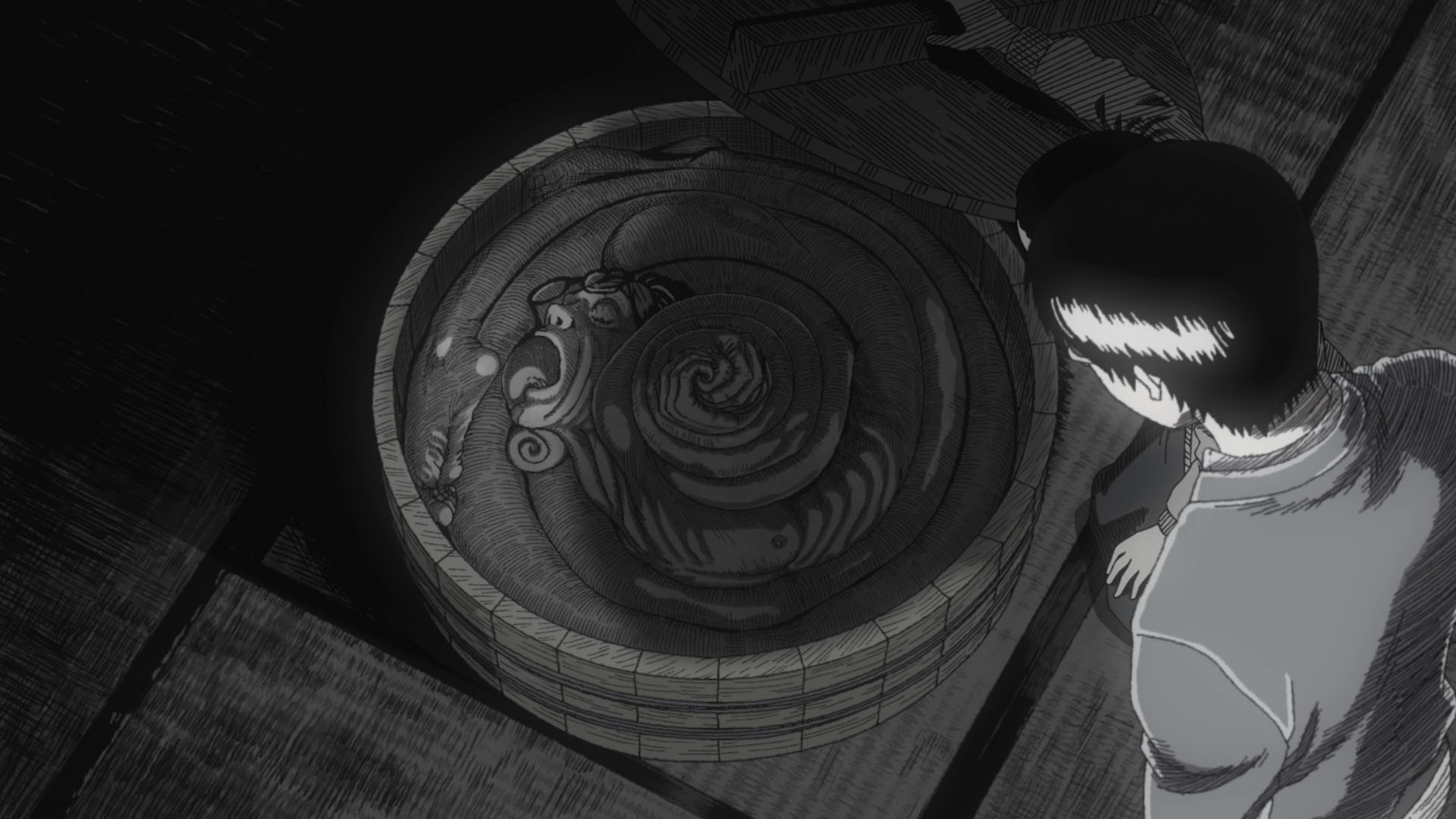
The biggest name in Japanese horror in any medium is prolific and enormously influential manga creator Junji Ito, whose celebrated catalog includes numerous body horror and psychological thriller stories. Ito’s arguable magnum opus is his 1998 award-winning manga series Uzumaki, which has now been adapted into an anime series produced by Production I.G USA and Adult Swim. The adaptation is a faithful recreation of Ito’s internationally best-selling story, from the black-and-white presentation to the cosmic body horror fueling a constant and steadily increasing sense of dread.
As with the manga story, the Uzumaki anime series revolves around the imagery of spirals, something that triggers the more horrifically gruesome moments in the story right from the opening episode. This imagery and its characters’ increasingly disturbing fascination with it forms the narrative foundation of Uzumaki, leading to the grand question: What is the deal with these spirals in the anime series?
The Story of Uzumaki
Uzumaki takes place in a contemporary and sleepy Japanese small town of Kurouzu, following high schooler Kirie Goshima and her boyfriend Shuichi Sato. At the start of the series, Shuichi shares that his father has become obsessed with spirals, unable to break his fixation on the pattern leading to visible mental health issues that escalate into physical symptoms. As a direct result, Shuichi becomes withdrawn and deathly afraid of spirals, noticing the pattern’s appearance around Kurouzu as both of his parents become affected by the strange, violent obsession surrounding spirals.
However, this nightmarish phenomenon isn’t isolated to the Sato family, with other individuals gradually becoming drawn into the spirals proliferating around town. After Shuichi’s father dies contorting his entire body into a spiral, the subsequent funeral triggers a cosmic event that spreads the spirals’ impact on the minds of the townspeople. As the scale of disturbing incidents around town escalate, Kirie and Shuichi search for a way to escape from town, but find that this strange spiral-shaped curse isn’t willing to let them go.
Attack of the Killer Spirals
In selecting the spiral shape as the story’s visualized curse, both the manga and anime use this premise to highlight how common the shape can be found in everyday life. As the story progresses, random spirals start appearing prominently in the background of a given scene, providing an omnipresent role that even the most casual audience would find impossible to ignore. This is used to terrifying effect as the horrific stakes come into play, with one character going as far as to cut off their finger and toe tips when they notice a spiral pattern in the prints.
When Uzumaki takes a turn towards overt cosmic horror, the spiral imagery similarly plays a central role in upping the terror, from sinister cloud patterns taking on the shape to spiral-shaped singularities appearing to gruesomely consume those near its maw. The series premiere of Uzumaki also alludes directly to a recurring trope in Ito’s work, which is malevolence within female characters’ hair, in this case, hair tied up into a spiral shape. With its spiral premise, Uzumaki is playing on terror derived from a naturally and widely occurring geometric pattern where danger could spring from anywhere.
Junji Ito and the Spiral Imagery
As one might imagine, there are a multitude of inspirations and themes behind Ito’s usage of spirals in Uzumaki. The inciting image for Ito in developing the story was the idea of people living in long, spiral-shaped buildings in a strange town. Ito also wanted to bring a subversive edge of manga and anime tropes prevalent at the time, with gag manga employing spiral shapes on its characters’ rosy cheeks to denote a bright cheerfulness. With this in mind, Ito wanted to take the familiar pattern and thematically invert it into something frightening and disturbing on a visceral level, as is his usual style.
Ito is also a huge fan of noted American horror writer H.P. Lovecraft, and the spiral imagery symbolizes both a descent into madness that is a thematic cornerstone of Lovecraft’s work. Lovecraft also pioneered the literary concept of cosmic horror and its degrading effect on the human psyche throughout his stories and Uzumaki certainly features this theme prominently. In an afterword to the 2001 English-language translation of the series published in North America by Viz Media, Ito recalls being fascinated by spirals on snails and draining water, while musing that the pattern itself serves a visualization of infinity, with repeating cycles playing a major theme in the story.
Not for the faint of heart, Uzumaki captures much of what Junji Ito does so well in imbuing his stories with an escalating dread and gruesome body horror. The anime adaptation not only recreates the story beats but is able to replicate that uneasiness and mounting tension. And while spirals may initially seem like an odd choice to build an entire scary story around, in the hands of a horror virtuoso like Ito, this makes Uzumaki one of the most uniquely terrifying horror stories to come out of Japan in any medium.
New episodes of Uzumaki premiere Saturday nights at 12:30 a.m. ET (so technically Sunday mornings) on Adult Swim, culminating with the fourth and final episode on October 19.
The post Uzumaki: Why Spirals Terrify Junji Ito appeared first on Den of Geek.





